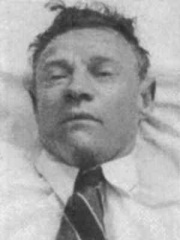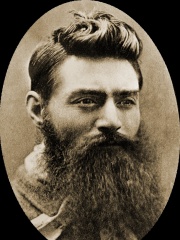

The Most Famous
MAFIOSOS from Australia
Top 2
The following people are considered by Pantheon to be the most legendary Australian Mafiosos of all time. This list of famous Australian Mafiosos is sorted by HPI (Historical Popularity Index), a metric that aggregates information on a biography's online popularity.

1. Tamam Shud case (1903 - 1948)
With an HPI of 73.29, Tamam Shud case is the most famous Australian Mafioso. Her biography has been translated into 25 different languages on wikipedia.
The Somerton Man was an unidentified man whose body was found on 1 December 1948 on the beach at Somerton Park, a suburb of Adelaide, South Australia. The case is also known by the Persian phrase tamám shud (تمام شد), meaning "It is over" or "It is finished", which was printed on a scrap of paper found months later in the fob pocket of the man's trousers. The scrap had been torn from the final page of a copy of Rubáiyát of Omar Khayyám, a poetry book. Following a public appeal by police, the book from which the page had been torn was located. On the inside back cover, detectives could read indentations left from previous handwriting: a local telephone number, another unidentified number, and text that resembled a coded message. The text has not been deciphered or interpreted in a way that satisfies authorities on the case. Since the early stages of the police investigation, the case has been considered "one of Australia's most profound mysteries". There has been intense speculation ever since regarding the identity of the victim, the cause of his death, and the events leading up to it. Public interest in the case remains significant for several reasons: the death occurred at a time of heightened international tensions following the beginning of the Cold War; the apparent involvement of a secret code; the possible use of an undetectable poison; and the inability or unwillingness of authorities to identify the dead man. On 26 July 2022, University of Adelaide professor Derek Abbott, in association with genealogist Colleen M. Fitzpatrick, concluded the man was Carl "Charles" Webb, an electrical engineer and instrument maker born in 1905, based on genetic genealogy from DNA of the man's hair. South Australia Police and Forensic Science South Australia have not verified the result, although they were hopeful of being able to do so.

2. Ned Kelly (1855 - 1880)
With an HPI of 66.35, Ned Kelly is the 2nd most famous Australian Mafioso. His biography has been translated into 40 different languages.
Edward Kelly (December 1854 – 11 November 1880) was an Australian bushranger, gang leader and police-murderer. One of the last bushrangers, he is known for wearing a suit of bulletproof armour during his final shootout with the police. Kelly was born and raised in rural Victoria, the third of eight children to Irish parents. His father, a transported convict, died in 1866, leaving Kelly, then aged 12, as the eldest male of the household. The Kellys were a poor selector family who saw themselves as downtrodden by the squattocracy and as victims of persecution by the Victoria Police. While a teenager, Kelly was arrested for associating with bushranger Harry Power and served two prison terms for a variety of offences, the longest stretch being from 1871 to 1874. He later joined the "Greta Mob", a group of bush larrikins known for stock theft. A violent confrontation with a policeman occurred at the Kelly family's home in 1878, and Kelly was indicted for his attempted murder. Fleeing to the bush, Kelly vowed to avenge his mother, who was imprisoned for her role in the incident. After he, his brother Dan, and associates Joe Byrne and Steve Hart shot dead three policemen, the government of Victoria proclaimed them outlaws. Kelly and his gang, with the help of a network of sympathisers, evaded the police for two years. The gang's crime spree included raids on Euroa and Jerilderie, and the killing of Aaron Sherritt, a sympathiser turned police informer. In a manifesto letter, Kelly—denouncing the police, the Victorian government and the British Empire—set down his own account of the events leading up to his outlawry. Demanding justice for his family and the rural poor, he threatened dire consequences for his enemies. In 1880, the gang tried to derail and ambush a police train as a prelude to attacking Benalla, the base of police operations in the region. The police, tipped off, confronted them at Glenrowan. In the ensuing 12-hour siege and gunfight, the outlaws wore armour fashioned from plough mouldboards. Kelly, the only survivor, was severely wounded by police fire and captured. Despite thousands of supporters rallying and petitioning for his reprieve, Kelly was tried for murder, convicted and hanged at the Melbourne Gaol. Historian Geoffrey Serle called Kelly and his gang "the last expression of the lawless frontier in what was becoming a highly organised and educated society, the last protest of the mighty bush now tethered with iron rails to Melbourne and the world". In the century after his death, Kelly became a cultural icon, inspiring numerous works in the arts and popular culture, and is the subject of more biographies than any other Australian. Kelly continues to cause division in his homeland: he is variously considered a Robin Hood-like folk hero and crusader against oppression, and a murderous villain and terrorist. Journalist Martin Flanagan wrote: "What makes Ned a legend is not that everyone sees him the same—it's that everyone sees him. Like a bushfire on the horizon casting its red glow into the night."
People
Pantheon has 2 people classified as Australian mafiosos born between 1855 and 1903. Of these 2, none of them are still alive today. The most famous deceased Australian mafiosos include Tamam Shud case, and Ned Kelly.

